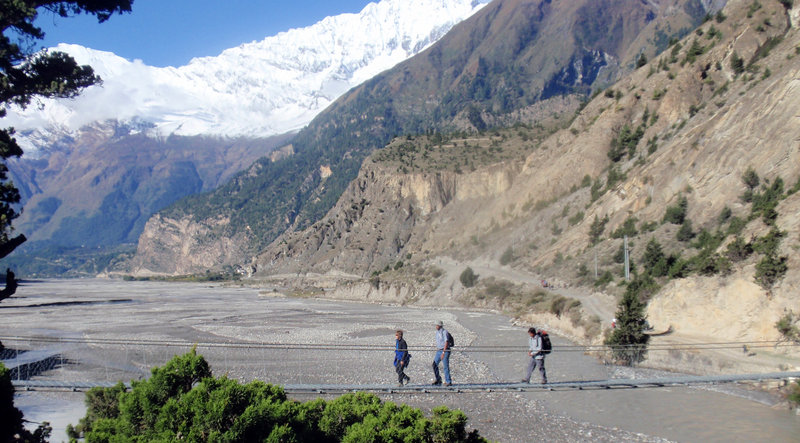The setting resembled a stunning picture postcard come to life.
Soaring, snow-capped mountains provided a backdrop for green-clad terraces carved out of steep hillsides. In fields below, men and women wearing colorful clothing bent low to pick golden shoots and tie them into huge bundles, which they carried to a rickety wooden wagon pulled by water buffalo.
Scenes like this make Nepal a destination that surpasses its already intriguing image of incredible natural beauty and fascinating lifestyles.
That small country about the size and shape of Tennessee, tucked between India and Tibet, is home to eight of the 10 highest mountains in the world, including fabled Everest.
Nepal also is a nation where religion is as much a part of everyday life as eating and breathing. While about 90 percent of the people are Hindu, and most of the rest Buddhist, the line dividing those faiths has virtually disappeared over the last 2,000 years. Many people worship the gods of both religions and hold sacred the shrines of the other.
The natural place to begin a visit is Kathmandu, the political, financial and cultural capital where about 10 percent of the approximately 29 million Nepalese live.
The sing-song cry of street vendors selling vegetables, spices and multicolored fabric is echoed by the occasional mooing of a sacred cow wandering serenely along the streets.
The oldest neighborhoods are mazes of cobblestone back streets lined by tiny shops and small shrines. These are miniscule imitations of elaborately carved and gaily painted ancient temples, pagodas and monuments said to be the largest collection of religious architecture in the world.
The biggest concentration of shrines is in Durbar Square, a jumble of more than 50 temples and other structures built over centuries. They’re adorned by statues of humans, animals, gods and goddesses.
This other-wordly setting is echoed nearby. Patan and Bhaktapur, two sister cities to Kathmandu, each has its own Durbar Square.
Venturing outside the Kathmandu valley introduces you to another, captivating world. In remote villages with narrow streets, people go about their daily chores much as generations of their forebears did. Most eke out a living growing rice, wheat, maize and other staples of the diet.
In the north, near the border with Tibet, the rugged Himalayan mountains loom overhead, their jagged peaks blanketed year-round by deep snow and ice fields.
Further south is the mid-mountain region, where peaks that elsewhere would rate as giants are relegated to second-class status.
Southern Nepal comprises the Terai, a subtropical belt of low-lying plains where much of the nation’s food is grown. As many as 100 distinct ethnic groups make up the native population, most speaking their own dialect and many identifiable by unique clothing and customs.
The majority of travelers visit Nepal for treks through the countryside and up mountains that last from several days to several weeks. I enjoyed a truncated two-day journey by foot, which led through tiny villages.
The hike didn’t come close in terms of time or challenge to the two most popular routes — around the Annapurna massif, or the longer journey to the Mount Everest base camp perched at 17,700 feet.
Even so, walking at an altitude of nearly 9,000 feet, following long stretches of stone paths clinging to steep hillsides, was challenge enough.
A very different environment awaits visitors to the grasslands and forests of the fertile Terai region, home to an abundance of wildlife. Elephants, tigers, leopard, rhinoceros and wild boar are among residents that roam jungle-like stretches of the area. Monkeys chatter in the trees overhead, and crocodiles and alligators lie hidden in stream waters.
The habitat also attracts nearly 600 lowland species of birds.
The best place for close-up animal encounters is Chitwan National Park.
As if the opportunity to spot a Noah’s Ark of wildlife in its natural habitat weren’t enough, the unusual mode of transportation renders animal sightings almost a bonus. Elephants line up like so many taxicabs, standing patiently as four passengers clamber up a ladder and take their place on a wooden platform strapped to each beast’s broad back.
Then, guided by a handler seated just behind its head, the massive pachyderm ambles into the dense jungle, nimbly stepping over fallen logs and gently traversing muddy bogs.
Victor Block is a freelance writer who lives in Washington, D.C., and spends summers in Rangeley.
Send questions/comments to the editors.



Comments are no longer available on this story